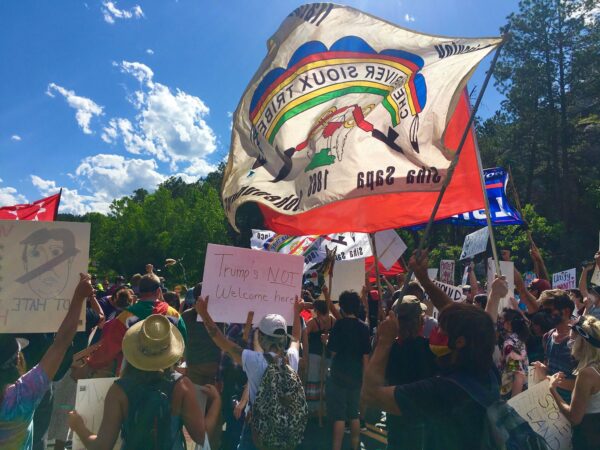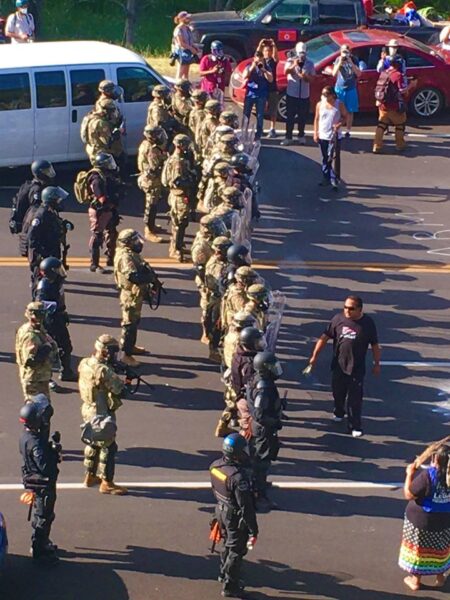
- Details
- By Levi Rickert
KEYSTONE, S.D. — In a twist of irony, American Indian protesters were met by Trump supporters yelling “go home” near the entry to Mount Rushmore on Friday.
The protesters were actually on their homeland as protected by the Treaty of Fort Laramie and upheld by a 1980 U.S. Supreme Court decision. The Sioux consider the Black Hills, where Mount Rushmore is located, sacred. They still refer to the sacred site as Paha Sapa.
“People were telling us to ‘go home’ and that’s where we were, on our sacred home lands. It shows how the american education system white-washes history and ignores the amount of injustice, genocide, and inequality that this country was built on,” Laura Ten Fingers (Oglala Sioux Tribe), one of the organizers, told Native News Online.
 Photograph by Peter HillThe protesters, whose numbers approached 300 by late afternoon, began showing up hours before the president’s appearance to celebrate the United States’ 244th birthday at Mount Rushmore.
Photograph by Peter HillThe protesters, whose numbers approached 300 by late afternoon, began showing up hours before the president’s appearance to celebrate the United States’ 244th birthday at Mount Rushmore.
The protesters, mostly from South Dakota Sioux tribes, were there to let President Donald Trump he was not welcome in their homeland. However, the president flew into Mount Rushmore aboard Marine One with his wife.
During the demonstration, a group of Native women sang as police presence grew. In the crowd, some protesters carried signs with various messages. Among them were: “You’re on Stolen Land,” and “Land Water Defender,” and “Land back.”
Militarized police were on the scene and sprayed the protesters with pepper spray to disburse the crowd. By 7:15 p.m. (local time) 15 protesters were arrested for refusing to leave. Three vehicles that blocked the South Dakota highway were loaded onto flatbed towing trucks and impounded.
“The biggest message that we have been trying to send this entire time is that Mount Rushmore is a symbol of white supremacy and racial injustice in this country and that the four faces carved on that mountain are the four faces of colonizers who have committed genocide on Indigenous people,” Nick Tilsen (Oglala Sioux Tribe), the executive director of NDN Collective and one of the protest organizers, told the Rapid City Journal.
 Lloyd Big Crow, Sr. smudged the military police. Photograph by Peter Hill.Tilsen was among those arrested defending their homeland.
Lloyd Big Crow, Sr. smudged the military police. Photograph by Peter Hill.Tilsen was among those arrested defending their homeland.
“It was a day fueled prayers and resilience of our ancestors,” Ten Fingers said. “We were there protecting our lands from white supremacists and from the possibility of wildfires and water contamination in the Black Hills.”
Later, Trump delivered on the eve of the Fourth of July what several newspapers labeled a divisive speech aimed at garnering more support in the upcoming presidential election from his base.
Darren Thompson contributed to this story.
More Stories Like This
Native News Weekly (August 25, 2024): D.C. BriefsUS Presidents in Their Own Words Concerning American Indians
Monday Morning (November 24, 2025): Articles You May Have Missed This Past Weekend
Navajo Nation President Nygren Defends Record, Says Speaker’s Actions ‘Disgraceful’ and Politically Driven
Native News Weekly (November 23, 2025): D.C. Briefs
Help us tell the stories that could save Native languages and food traditions
At a critical moment for Indian Country, Native News Online is embarking on our most ambitious reporting project yet: "Cultivating Culture," a three-year investigation into two forces shaping Native community survival—food sovereignty and language revitalization.
The devastating impact of COVID-19 accelerated the loss of Native elders and with them, irreplaceable cultural knowledge. Yet across tribal communities, innovative leaders are fighting back, reclaiming traditional food systems and breathing new life into Native languages. These aren't just cultural preservation efforts—they're powerful pathways to community health, healing, and resilience.
Our dedicated reporting team will spend three years documenting these stories through on-the-ground reporting in 18 tribal communities, producing over 200 in-depth stories, 18 podcast episodes, and multimedia content that amplifies Indigenous voices. We'll show policymakers, funders, and allies how cultural restoration directly impacts physical and mental wellness while celebrating successful models of sovereignty and self-determination.
This isn't corporate media parachuting into Indian Country for a quick story. This is sustained, relationship-based journalism by Native reporters who understand these communities. It's "Warrior Journalism"—fearless reporting that serves the 5.5 million readers who depend on us for news that mainstream media often ignores.
We need your help right now. While we've secured partial funding, we're still $450,000 short of our three-year budget. Our immediate goal is $25,000 this month to keep this critical work moving forward—funding reporter salaries, travel to remote communities, photography, and the deep reporting these stories deserve.
Every dollar directly supports Indigenous journalists telling Indigenous stories. Whether it's $5 or $50, your contribution ensures these vital narratives of resilience, innovation, and hope don't disappear into silence.
 The stakes couldn't be higher. Native languages are being lost at an alarming rate. Food insecurity plagues many tribal communities. But solutions are emerging, and these stories need to be told.
The stakes couldn't be higher. Native languages are being lost at an alarming rate. Food insecurity plagues many tribal communities. But solutions are emerging, and these stories need to be told.
Support independent Native journalism. Fund the stories that matter.
Levi Rickert (Potawatomi), Editor & Publisher

